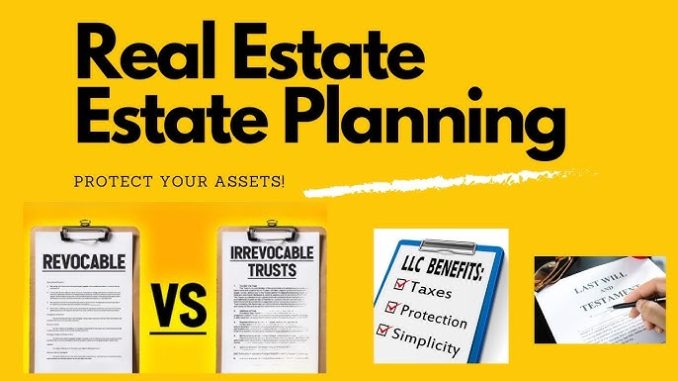
Estate planning is an essential part of financial security that ensures your assets are protected and distributed according to your wishes. Many people assume that estate planning is only for the wealthy, but in reality, everyone can benefit from having a plan in place. Whether you own a home, have savings, or want to provide for your loved ones, estate planning can help safeguard your assets and minimize complications for your heirs.
In this guide, we’ll explore why estate planning is important, key strategies to protect your wealth, and how to get started.
Why Estate Planning Matters
Without a solid estate plan, your assets could be subject to unnecessary taxes, legal battles, and distribution delays. Estate planning allows you to:
- Ensure your assets go to the right beneficiaries – Without a will or trust, state laws determine how your assets are divided.
- Minimize taxes – Proper planning can reduce estate taxes and other financial burdens for your heirs.
- Avoid probate – Probate is the legal process of distributing your assets, which can be lengthy and costly.
- Protect your loved ones – Estate plans can designate guardians for minor children and provide for dependents.
- Maintain privacy – A well-structured estate plan can keep your financial matters confidential.
Key Elements of an Estate Plan
1. Will and Testament
A will is a legal document that specifies how your assets should be distributed after your death. It also allows you to name an executor, who will manage the process of settling your estate. If you die without a will, your assets will be distributed based on state laws, which may not align with your wishes.
2. Trusts for Asset Protection
A trust is an advanced estate planning tool that helps manage your assets during your lifetime and after your passing. Trusts can:
- Bypass probate, ensuring faster asset distribution.
- Protect assets from creditors and lawsuits.
- Reduce estate taxes in certain situations.
- Set specific conditions for how and when beneficiaries receive assets.
Common types of trusts include:
- Revocable Living Trust – Allows you to control your assets while alive and designate how they should be distributed after your passing.
- Irrevocable Trust – Once established, the terms cannot be changed, offering greater asset protection and tax benefits.
- Special Needs Trust – Provides for a disabled loved one without affecting their eligibility for government benefits.
3. Durable Power of Attorney
A power of attorney (POA) allows you to appoint someone to manage your financial and legal affairs if you become incapacitated. Without one, your loved ones may have to go through court proceedings to gain control over your assets, which can be time-consuming and expensive.
4. Healthcare Directives
A healthcare directive, also known as a living will or medical power of attorney, outlines your preferences for medical treatment if you become unable to communicate. It also allows you to appoint a trusted person to make healthcare decisions on your behalf.
5. Beneficiary Designations
Certain assets, such as life insurance policies, retirement accounts, and bank accounts, allow you to name beneficiaries. Keeping these designations up to date ensures your assets are transferred directly to the intended individuals without going through probate.
How to Protect Your Assets from Probate
Probate is the legal process of distributing your estate, which can be time-consuming and costly. To avoid probate:
- Use a trust – Assets placed in a trust bypass probate.
- Name beneficiaries – Retirement accounts, life insurance policies, and payable-on-death accounts avoid probate when beneficiaries are designated.
- Hold property jointly – Joint ownership with rights of survivorship allows assets to transfer automatically to the surviving owner.
Reducing Estate Taxes
If you have a large estate, taxes can significantly reduce the amount your heirs receive. Strategies to minimize taxes include:
- Gifting assets during your lifetime – The IRS allows tax-free annual gifts up to a certain limit per recipient.
- Creating an irrevocable life insurance trust (ILIT) – This removes life insurance proceeds from your taxable estate.
- Charitable donations – Leaving assets to charity can reduce estate tax liability while supporting causes you care about.
Protecting Your Assets from Creditors
If you have significant wealth, you may need protection from lawsuits, divorce settlements, or creditors. Ways to safeguard assets include:
- Irrevocable trusts – Assets placed in an irrevocable trust are not considered part of your estate, protecting them from creditors.
- Limited Liability Companies (LLCs) – Holding real estate or business assets in an LLC can shield personal assets from lawsuits.
- Homestead exemptions – Some states offer legal protection for primary residences against creditors.
Common Estate Planning Mistakes to Avoid
- Not having an estate plan – Without one, your assets could be distributed based on state laws rather than your wishes.
- Failing to update your plan – Major life changes like marriage, divorce, or new children should prompt an estate plan review.
- Ignoring tax implications – Failing to plan for estate taxes can reduce the wealth passed to heirs.
- Not considering long-term care costs – Long-term care can deplete assets if not accounted for in your plan.
- Choosing the wrong executor or trustee – Select someone responsible and trustworthy to carry out your wishes.
How to Get Started with Estate Planning
- Take inventory of your assets – List all financial accounts, real estate, business interests, and valuable possessions.
- Determine your beneficiaries – Decide who should inherit your assets and in what proportions.
- Consult an estate planning attorney – While DIY options exist, a legal expert can help ensure your plan complies with state laws.
- Establish key documents – Create a will, trust (if needed), power of attorney, and healthcare directive.
- Review and update regularly – Periodically review your plan to ensure it reflects your current circumstances.